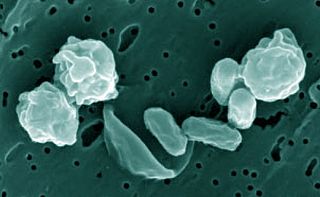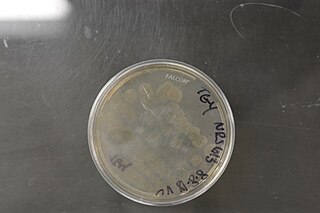
Geobacillus stearothermophilus is a rod-shaped, Gram-positive bacterium and a member of the phylum Bacillota. The bacterium is a thermophile and is widely distributed in soil, hot springs, ocean sediment, and is a cause of spoilage in food products. It will grow within a temperature range of 30 to 75 °C. Some strains are capable of oxidizing carbon monoxide aerobically. It is commonly used as a challenge organism for sterilization validation studies and periodic check of sterilization cycles. The biological indicator contains spores of the organism on filter paper inside a vial. After sterilizing, the cap is closed, an ampule of growth medium inside of the vial is crushed and the whole vial is incubated. A color and/or turbidity change indicates the results of the sterilization process; no change indicates that the sterilization conditions were achieved, otherwise the growth of the spores indicates that the sterilization process has not been met. Recently a fluorescent-tagged strain, Rapid Readout(tm), is being used for verifying sterilization, since the visible blue fluorescence appears in about one-tenth the time needed for pH-indicator color change, and an inexpensive light sensor can detect the growing colonies.

Pore-forming proteins are usually produced by bacteria, and include a number of protein exotoxins but may also be produced by other organisms such as apple snails that produce perivitellin-2 or earthworms, who produce lysenin. They are frequently cytotoxic, as they create unregulated pores in the membrane of targeted cells.
Lysinibacillus sphaericus is a Gram-positive, mesophilic, rod-shaped bacterium commonly found on soil. It can form resistant endospores that are tolerant to high temperatures, chemicals and ultraviolet light and can remain viable for long periods of time. It is of particular interest to the World Health Organization due to the larvicide effect of some strains against two mosquito genera, more effective than Bacillus thuringiensis, frequently used as a biological pest control. L. sphaericus cells in a vegetative state are also effective against Aedes aegypti larvae, an important vector of yellow fever and dengue viruses.

Bacillus odysseyi is a Gram-positive, aerobic, rod-shaped, round-spore- and endospore-forming eubacterium of the genus Bacillus. This novel species was discovered by scientist Myron T. La Duc of NASA’s Biotechnology and Planetary Protection Group, a unit whose purpose is to clean and sterilize spacecraft so as not to have microorganisms contaminate other celestial bodies or foreign microorganisms contaminate Earth, on the surface of the Mars Odyssey in a clean room at the Jet Propulsion Laboratory in La Cañada Flintridge before the spacecraft was launched to space. La Duc named the bacterium Bacillus odysseyi sp. nov. after the Odyssey mission. It had apparently evolved to live in the sparse environment of a clean room, and its secondary spore coat makes it especially resistant to radiation.
Bacillus halodurans is a rod-shaped, Gram-positive, motile and spore-forming bacterium found in soil. In a genomic comparison with Bacillus subtilis, B. halodurans strain C-125 - originally an unclassified Bacillus strain - was found to contain unique genes and sigma factors that may have aided its adaptation to more alkaline environments.
Alkalihalobacillus alcalophilus is a Gram-positive, rod-shaped species of bacteria. Likely strains of this species have been isolated from highly alkaline waste water. A. alcalophilus is a moderate halotolerant obligate alkaliphile growing at 40 °C and at pH 9–10.5 that has been isolated from soil and animal manures.
Bacillus arseniciselenatis is a bacterium first isolated from Mono Lake, California. It is notable for respiring oxyanions of selenium and arsenic. It is spore-forming, rod-shaped and alkaliphile, its type strain being E1H. It is a strict anaerobe.
Lysinibacillus fusiformis is a gram-positive, rod-shaped bacterium of the genus Lysinibacillus. Scientists have yet to completely characterize this microbe's pathogenic nature. Though little is known about this organism, several genome sequencing projects for various strains of L. fusiformis are currently underway.
Virgibacillus is a genus of Gram-positive, rod-shaped (bacillus) bacteria and a member of the phylum Bacillota. Virgibacillus species can be obligate aerobes, or facultative anaerobes and catalase enzyme positive. Under stressful environmental conditions, the bacteria can produce oval or ellipsoidal endospores in terminal, or sometimes subterminal, swollen sporangia. The genus was recently reclassified from the genus Bacillus in 1998 following an analysis of the species V. pantothenticus. Subsequently, a number of new species have been discovered or reclassified as Virgibacillus species.
Jeotgalibacillus alimentarius is a bacterium, the type species of its genus. It was first isolated from jeotgal, hence its name. It is a moderately halophilic, round-endospore-forming bacterium, with type strain YKJ-13T.
Bacillus boroniphilus is a species of highly boron-tolerant bacterium, hence its name. It is Gram-positive, motile, and rod-shaped, with type strain T-15ZT. Its genome has been sequenced.
Ureibacillus is a genus of gram-negative bacteria within the largely gram-positive Bacillota. Ureibacilli are motile and form spherical endospores. The type species of the genus is Ureibacillus thermosphaericus.
Bhargavaea beijingensis is a Gram-positive, moderately halotolerant and non-motile bacterium from the genus of Bhargavaea which has been isolated from the root of a ginseng plant.
Bhargavaea ginsengi is a Gram-positive, moderately halotolerant and non-motile bacterium from the genus of Bhargavaea which has been isolated from the roots of a ginseng plant in Beijing in China.
Solibacillus isronensis is a bacterium from the genus of Solibacillus which has been isolated from a cryogenic tube from India. It is named after ISRO, India's space agency which discovered the species.
Alkalihalobacillus is a genus of gram-positive or gram-variable rod-shaped bacteria in the family Bacillaceae from the order Bacillales. The type species of this genus is Alkalihalobacillus alcalophilus.
Neobacillus is a genus of rod-shaped bacteria that show Gram-positive or Gram-variable staining. This genus belongs under the family Bacillaceae within the order Bacillales. The type species of Neobacillus is Neobacillus niacini.

Cytobacillus is a genus of rod-shaped bacteria that stain either Gram-positive or Gram-variable in the family Bacillaceae within the order Bacillales. The type species for this genus is Cytobacillus firmus.
Alkalicoccus is a genus of Gram-Positive rod-shaped bacteria in the family Bacillaceae from the order Bacillales. The type species of this genus is Alkalicoccus saliphilus.
Lysinibacillus is a genus of bacteria from the family of Bacillaceae. Members of this genus, in contrast to the type species of the genus Bacillus, contains peptidoglycan with lysine, aspartic acid, alanine and glutamic acid.



